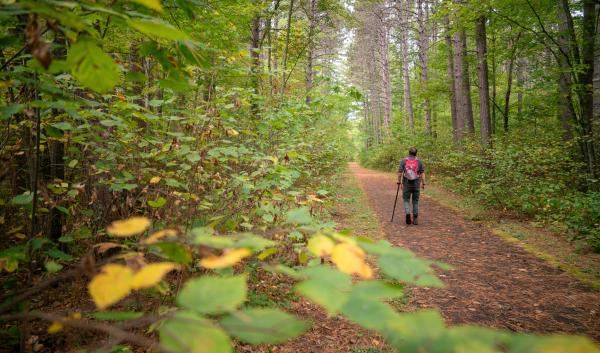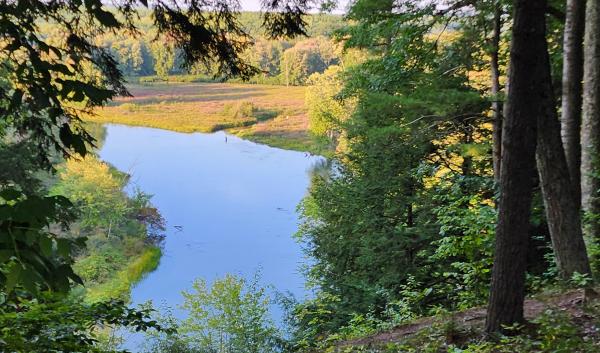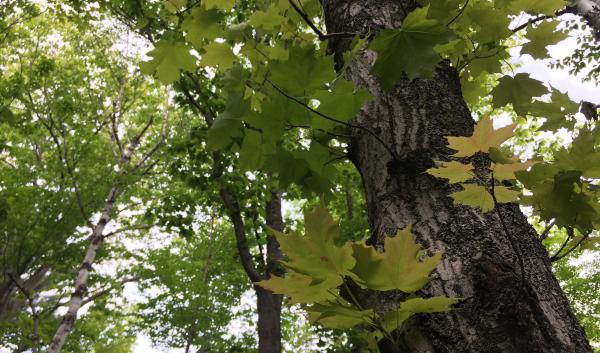This assessment synthesizes the best available scientific information on climate change and forest ecosystems. Its primary goal is to inform forest managers in the Central Hardwoods region, in addition to other people who study, recreate, and live in these forests.

Forests and ecosystems in the Central Hardwoods region will be affected directly and indirectly by a changing climate over the next 100 years. Understanding the potential impacts is an important first step to sustaining healthy forests in the face of changing conditions.
This assessment evaluates the vulnerability of nine natural communities in the Central Hardwoods region of Illinois, Indiana, and Missouri to a range of future climates.
This assessment synthesizes information on the contemporary landscape, provides information on past climate trends, and describes a range of projected future climates. This information was also used to parameterize and run multiple forest impact models, which provided a range of potential tree responses to climate. Results were vetted by a multidisciplinary panel of scientists and land managers familiar with the natural communities of this region to assess vulnerability through a formal consensus-based expert elicitation process. Vulnerability is described in terms of the potential impacts on a system and the adaptive capacity of the system.
Major Findings
- Analysis of climate records indicates that average temperatures and total precipitation in the region have increased.
- Downscaled climate models project potential increases in temperature in every season, but vary in projections for precipitation.
- The forest impact models project declines in growth and suitable habitat for many mesic species, including American beech, eastern hemlock, eastern white pine, red spruce, and sugar maple. Species that tolerate hotter, drier conditions are projected to persist or increase, including black oak, northern red oak, pignut hickory, sweetgum, and white oak.
- The montane spruce-fir and lowland conifer forest communities were determined to be the most vulnerable ecosystems in the interior portion of the Mid-Atlantic region.
- Maritime and tidal swamp forest communities were determined to be the most vulnerable ecosystems in the coastal plain portion of the region.
- The woodland, glade, and barrens forest community was perceived as less vulnerable to projected changes in climate.
- These projected changes in climate and the associated impacts and vulnerabilities will have important implications for economically valuable timber species, forest-dependent animals and plants, recreation, and long-term natural resource planning.
Details Of The Vulnerability Assessment
The information below is a summary of each chapter available in the vulnerability assessment. For more information and in-depth discussion please refer to the full report.
This chapter describes the forests and related ecosystems across the Central Hardwoods landscape and summarizes current threats and management trends. This information lays the foundation for understanding how shifts in climate may contribute to changes in Central Hardwoods ecosystems, and how climate may interact with other stressors on the landscape.
The assessment area of the Central Hardwoods region contains about 42 million acres, of which 40 percent is classified as forest land. Private individuals and organizations own approximately 80 percent of forest land.
- Due to a general lack of influence by topography or large bodies of water, the climate of the region is driven by large air masses from the Arctic in winter and the Gulf of Mexico in summer. The climate is generally characterized as a humid continental climate, with cool winters and long, hot summers.
- Oak/hickory, elm/ash/cottonwood, and oak/pine are the most abundant forest-type groups across the area.
- Current major stressors and threats to Central Hardwoods forest ecosystems include fragmentation and land-use change, loss of historical fire regime in fire-adapted systems, extreme weather, forest diseases, and insect pests, nonnative invasive plant species, loss of soil, and reduced diversity of species and age classes.
- The forest products and forest-related recreation industries are major contributors to the regional economy, and an increasing amount of forest land is managed according to a sustainability certification standard.
- Nine forest ecosystems are used to describe the forests in the Central Appalachian region. The descriptions of forest communities were based on NatureServe terrestrial ecosystems and crosswalked to FIA forest-type groups and state classification systems.
This chapter provides a brief background on climate change science, models that simulate future climate change, and forest impact models that project the effects of climate change on tree species and ecosystems. This chapter also describes the climate data used in this assessment.
- Temperatures have increased at a global scale and across the United States over the past century. Climate scientists attribute this increase in temperature to increases in greenhouse gases resulting from human activities.
- Scientists use models, which are simplified representations of reality, to simulate future climates. In this assessment, general circulation models are used to project future climate and as inputs to forest impact models. The GFDL model developed by the National Oceanic and Atmospheric Administration is considered moderately sensitive to changes in greenhouse gas concentrations, and the PCM model developed by the National Center for Atmospheric Research is considered to have low sensitivity to greenhouse gas concentrations.
- General circulation models require estimates of future greenhouse gas concentrations. This assessment pairs the GFDL model with the most fossil-fuel intensive scenario developed by the Intergovernmental Panel on Climate Change [IPCC] Special Report on Emission Scenarios (A1FI) and pairs the PCM model with the least fossil-fuel intensive scenario (B1). These two model-scenario combinations represent the ends of a range of possible climate futures which are logical trajectories from the current climate.
- Climate projections for this assessment were statistically downscaled by using an asynchronous regional regression model. Daily mean, minimum, and maximum temperature and total daily precipitation were downscaled to an approximately 7.5-mile resolution grid across the United States.
- Downscaled climate projections from general circulation models provide important information about future climate, but forest impact models are required to explore how climate change may affect soil moisture, hydrology, forest composition, productivity, or interactions between these factors. In this assessment, we used one species distribution model, the Climate Change Tree Atlas, and two process models, LINKAGES and LANDIS PRO. These forest impact models operate at different spatial scales and provide different kinds of information.
Many of the climatic changes that have been observed across the world over the past century are also evident in the assessment area. This chapter summarizes our current understanding of observed changes and current climate trends across the Central Hardwoods region, with a focus on the last 100 years.
- Over the last century, mean maximum temperatures generally decreased and mean minimum temperatures generally increased across all seasons, leading to less daily variation in temperature.
- The region is receiving 12 to 17 percent more precipitation, particularly in the spring and fall since the turn of the last century. The number of intense precipitation events has increased.
- A decrease in snow cover has led to an increase in soil frost across the area since the 1970s.
- There is little evidence for changing trends in severe weather, such as tornadoes, derechos, and thunderstorms.
This chapter describes climate projections for the assessment area over the 21st century. Temperature and precipitation projections are derived from downscaled simulations of climate models. Published scientific literature provides the basis for describing possible trends in a range of climate-driven processes, such as extreme weather events and snowfall.
- Temperatures are expected to increase over the next century, under a range of climate scenarios and in all seasons.
- Precipitation is projected to increase by 2 to 5 inches in winter and spring across a range of climate scenarios. Projections of summer and fall precipitation are more variable, increasing or decreasing, depending on the model.
- Data from a hydrologic model indicate a slight increase in water availability on an annual basis. Spring precipitation was projected to show the biggest increase in water availability, and a decrease was projected for summer.
- Increases in temperature during winter months are expected to lead to decreases in snow duration and extent across the region in the coming decades.
- The growing season length is expected to increase by up to 1 month. The number of extremely hot days is expected to increase.
This chapter summarizes the potential impacts of climate change on forests in the assessment area, drawing on information from a coordinated series of model simulations and published research.
- Many tree species that are currently present may fare worse under warmer temperatures and altered precipitation patterns, including sugar maple and northern red oak.
- Models also project that habitat suitability for many other species will increase, including shortleaf pine, loblolly pine, post oak, and blackjack oak.
- Model projections for northern red oak, scarlet oak, and black oak vary by impact model and climate scenario across much of the region.
- Changes in climate are not projected to have a dramatic effect on many common species in the region, including eastern redcedar and white oak.
- The model projections used in this assessment do not account for many other factors that may change under a changing climate. Scientific literature was used to provide additional information on drought stress, wildfires, acid deposition and nutrient cycling, pests and pathogens, herbivory, and many interactions between factors.
This chapter focuses on the vulnerability of nine natural communities in the Central Hardwoods region to climate change, with an emphasis on shifts in dominant tree species, features that define a system (drivers), and features that disturb a system (stressors). The adaptive capacity of each natural community was also examined as a key component to overall vulnerability. Adaptive capacity is the ability of a species or ecosystem to accommodate or cope with potential climate change impacts with minimal disruption (Glick et al. 2011, IPCC 2007).
We further rated the evidence used in assessing vulnerability as well as the level of agreement between sources of evidence. We consider a system to be vulnerable if it is at risk of a species composition change leading to a substantially different character for the forest system, or if the system is anticipated to suffer substantial declines in acreage, health, or productivity. General trends in climate change impacts and adaptive capacity factors for the Central Hardwoods region are also captured in overarching synthesis statements.
Potential impacts of climate change on ecosystem drivers and stressors
- Temperatures will increase (robust evidence, high agreement). All downscaled climate models agree that temperatures will increase across much of the assessment area.
- Growing seasons will lengthen (medium evidence, high agreement). There is strong agreement among evidence that projected temperature increases will continue to lengthen growing seasons in the region.
- The nature and timing of precipitation will change (robust evidence, high agreement). All downscaled climate models agree that there will be changes in precipitation patterns, but the direction of changes may change monthly or seasonally.
- An increase in heavy precipitation events (medium evidence, medium agreement) may result in flood risks (limited evidence, medium agreement) and soil erosion (limited evidence, medium agreement). There is disagreement among models about whether heavy precipitation events will continue to increase in the assessment area. If they do increase, it is expected that flooding and soil erosion will increase as well, but these effects have not been modeled for this region.
- Snow will decrease, with subsequent decreases in soil frost (high evidence, high agreement). Evidence suggests that winter temperatures will increase in the area, even under low emissions, leading to changes in snow and soil frost. Soil moisture patterns will change (medium evidence, high agreement) with drier soil conditions later in the growing season (medium evidence, low agreement). Some studies show that climate change will have impacts on soil moisture, but there is disagreement among climate and impact models on how soil moisture will change during the growing season. Droughts will increase in duration and area (medium evidence, low agreement). A study using multiple climate models suggests that drought may increase in extent and area, but another suggests a decrease in drought.
- Climate conditions will increase wildfire risk by the end of the century (medium evidence, high agreement). Some national and global studies suggest that conditions favorable for wildfire will increase, but few studies have specifically looked at wildfire risk in the Central Hardwoods region.
- Many invasive species, insect pests, and pathogens will increase or become more severe (medium evidence, high agreement). Evidence suggests that an increase in temperature and greater ecosystem stress will lead to increases in these threats, but research to date has examined few species.
Potential impacts of climate change on forest communities
- Suitable habitat for northern species will decline (medium evidence, high agreement). All three impact models project a decrease in suitability for northern species such as sugar maple, American beech, and white ash.
- Habitat will become more suitable for southern species (medium evidence, high agreement). All three forest impact models project an increase in suitability for southern species such as shortleaf pine.
- Communities will shift across the landscape (low evidence, high agreement). Although few models have examined community shifts specifically, model results from individual species and ecological principles suggest communities may also shift.
- Increased fire frequency and harvesting may accelerate shifts in forest composition across the landscape (medium evidence, medium agreement). Studies from other regions (e.g., northern hardwoods and boreal forests) show that increased fire frequency can accelerate the decline of species negatively affected by climate warming and accelerate the northward migration of southern tree species.
- A major transition in forest composition is not expected to occur in the coming decades (medium evidence, medium agreement). Although some models indicate major changes in habitat suitability, results from spatially dynamic forest landscape models indicate that a major shift in forest composition across the landscape may take 100 years or more in the absence of major disturbances.
- Little net change in forest productivity is expected (medium evidence, low agreement). Although many studies have examined the impact of climate change on forest productivity, they disagree on how multiple factors may interact to influence it.
Adaptive capacity factors
- Low-diversity forest communities are at greater risk (medium evidence, high agreement). Studies have consistently shown that diverse systems are more resilient to disturbance, and low-diversity ecosystems are more vulnerable to change.
- Species in fragmented landscapes will have less opportunity to migrate to long distances in response to climate change (limited evidence, high agreement). Evidence suggests that species may not be able to disperse over the distances required to keep up with climate change, but little research has been done in the region on this topic.
- Fire-adapted ecosystems will be more resilient to climate change (high evidence, medium agreement). Studies have shown that fire-adapted ecosystems are better able to recover after disturbances and can promote many of the species that area expected to do well in a changing climate.
- Ecosystems that are highly limited to by hydrologic regime or geological features may be topographically constrained (limited evidence, medium agreement). Our current ecological understanding indicates that migration to new areas may be impossible for tree species and forest communities with narrow habitat requirements.
This chapter summarizes climate change impacts on decision-making and management for public and private lands across the Central Hardwoods Region. These impacts will vary by ecosystem, ownership, and management objective. This chapter does not make recommendations as to how management should be adjusted to cope with these impacts, because impacts and responses will differ by ecosystem, ownership, and management objective.
- Plants, animals, and people that depend on forests may face additional challenges as temperatures increase and precipitation patterns shift.
- Greater financial investments may be required to maintain healthy forests and resilient infrastructure and to prepare for severe weather events.
- The seasonal timing of management activities such as prescribed burns or recreation activities such as waterfowl hunting may need to be altered as temperatures and precipitation patterns change.
- Confronting the challenge of climate change presents opportunities for managers and other decision-makers to plan, foster resilient landscapes, and ensure that the benefits that forests provide are sustained into the future.
How To Cite This Report
Brandt, Leslie A.; He, Hong; Iverson, Louis R.; Thompson, Frank R., III; Butler, Patricia; Handler, Stephen; Janowiak, Maria; Shannon, P. Danielle; Swanston, Christopher; Albrecht, M. Blume-Weaver, R.: Deizman, P.; DePuy, J.: Dijak, William D.; Dinkel, G.; Fei, Songlin; Jones-Farrand, D. Todd; Leahy, M.; Matthews, Stephen; Nelson, P.; Oberle, B.; Perez, J.; Peters, Matthew; Prasad, Anantha; Schneiderman, J.E.; Shuey, J.; Smith, Adam B.; Studyvin, C.; Tirpak, J.M.; Walk, J.W.; Wang, W.J.; Watts, L.; Weigel, D.; Westin, S. 2014. Central Hardwoods Ecosystem Vulnerability Assessment and Synthesis: a report from the Central Hardwoods Climate Change Response Framework project. Gen. Tech. Rep. NRS-124. Newtown Square, PA: U.S. Department of Agriculture, Forest Service, Northern Research Station. 254 p. https://doi.org/10.2737/NRS-GTR-124




